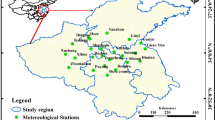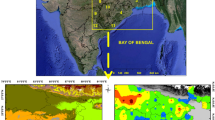Abstract
A spatial analysis of partial duration series, PDS, of the dry spell lengths, DSL, is applied to 267 European stations during years 1951–2000. A DSL is defined as the number of consecutive days with precipitation below 0.1 mm/day. For every station, PDS are made of DSL longer than those corresponding to 95th empirical percentile. The L-skewness and L-kurtosis diagram of the PDS distributions shows that most of the stations fit well a generalised Pareto, GP, model. Only four rain gauge records at the southeast Mediterranean coast notably depart from this model. In addition, DSL maps for return periods of 2, 5, 10, 25 and 50 years are introduced by taking into account GP parameters, which are estimated by fitting the GP distribution to empirical PDS distributions of DSL. A comparative study with those obtained in a previous paper, for the whole DSL series and the corresponding best distribution model (Pearson type III), shows that the differences of DSL for the different return periods keep within ±10 % in most of rain gauges. Moreover, a principal component analysis, PCA, is applied to the four first L-moments of the 267 rain gauges. Then, a regionalization in 11 groups is obtained after the clustering process. Finally, a regional frequency analysis is attempted, being possible to assign a GP parent distribution with different parameters to 7 out of the 11 groups.















Similar content being viewed by others
References
Anagnostopoulou C, Maheras P, Karacostas T, Vafiadis M (2003) Spatial and temporal analysis of dry spells in Greece. Theor Appl Climatol 74:77–91
Ashkar F, Tatsambon CN (2007) Revisiting some estimation methods for the generalized Pareto distribution. J Hydrol 346:136–143
Beguería S (2005) Uncertainties in partial duration series modelling of extremes related to the choice of the threshold value. J Hydrol 303:215–230
Benjamin JR, Cornell CA (1970) Probability, statistics and decision for civil engineers. McGraw-Hill, New York
Ben-Zvi A (2009) Rainfall intensity–duration–frequency relationships derived from large partial duration series. J Hydrol 367:104–114
Berger A, Goossens C (1983) Persistence of wet and dry spells at Uccle (Belgium). J Climate 3:21–24
Brunetti M, Maugeri M, Nanni T, Navarra A (2002) Droughts and extreme events in regional daily Italian precipitation series. Int J Climatol 22(5):543–558
Carvalho JRP, Assad ED, Evangelista SRM, Pinto HS (2013) Estimation of dry spells in three Brazilian regions—analysis of extremes. Atmos Res 132–133:12–21
Cindrić K, Pasarić Z, Gajić-Čapka M (2010) Spatial and temporal analysis of dry spells in Croatia. Theor Appl Climatol 102:171–184
Coles S (2001) An introduction to statistical modelling of extreme events. Springer Series in Statistics. Springer, Germany
Davis RE, Kalkstein LS (1990) Development of an automatic spatial synoptic climatological classification. Int J Climatol 10:769–794
Davison AC, Smith RL (1990) Models for exceedances over high thresholds. J R Stat Soc Ser B 52:393–442
Dixon WJ (1985) BMDP: biomedical computer program. UCLA, Los Angeles
Douguédroit A (1987) The variation of dry spells in Marseilles from 1865 to 1984. J Climatol 7:541–551
Ekanayake ST, Cruise JF (1993) Comparison of Weibull—an exponential-based partial duration stochastic flood models. Stoch Hydrol Hydraul 7:283–297
Galloy E, Martin S, Le Breton A (1982) Analyse de séquences de jours secs consécutifs. Application à 31 postes du réseau météorologique français. La Météorologie 28:5–24
Gao X, Giorgi F (2008) Increased aridity in the Mediterranean region under greenhouse gas forcing estimated from high resolution simulations with a regional climate model. Glob Planet Chang 62:195–209
Giorgi F, Lionello P (2008) Climate change projections for the Mediterranean region. Glob Planet Chang 63:90–104
Gong DY, Wang JA, Han H (2005) Trends of summer dry spells in China during the late twentieth century. Meteorol Atmos Phys 88:203–214
Groisman PY, Knight RW (2008) Prolonged dry episodes over the conterminous United States: new tendencies emerging during the last 40 years. J Climate 21:1850–1862
Hartmann DL, Klein Tank AMG, Rusticucci M, Alexander LV, Brönnimann S, Charabi Y, Dentener FJ, Duglokencky EJ, Easterling DR, Kaplan A, Soden BJ, Thorne PW, Wild M, Zhai PM (2013) Observations: atmosphere and surface. In: Stoker TF, Qin D, Plattner GK, Tignor M, Allen SK, Boschung J, Nauels A, Xia Y, Bex V, Midgley PM (eds) Climate change 2013: the physical science basis. Contribution of Working Group I to the Fifth Assessment Report of the Intergovernmental Panel of Climate Change. Cambridge University Press, Cambridge
Heinrich G, Gobiet A (2011) The future of dry and wet spells in Europe: a comprehensive study based on the ENSEMBLES regional climate models. Int J Climatol 32:1951–1970
Hertig E, Seubert S, Paxian A, Vogt G, Paeth H, Jacobeit J (2012) Changes of total versus extreme precipitation and dry periods until the end of the twenty-first century: statistical assessment for the Mediterranean area. Theor Appl Climatol. doi:10.1007/s00704-012-0639-5
Hoerling M, Eischeid J, Perlwitz J, Quan X, Zhang T, Pegion P (2012) On the increased frequency of Mediterranean drought. J Climate 25:2146–2161
Hosking JRM, Wallis JR (1997) Regional frequency analysis. An approach based on L-moments. Cambridge University Press, Cambridge, 224 pp
Jolliffe IT (1986) Principal components analysis. Springer series in statistics. Springer Verlag, New York, 271
Kalkstein LS, Tan G, Skindlov JA (1987) An evaluation of three clustering procedures for use in synoptic climatological classification. J Clim Appl Meteorol 26:717–730
Klein Tank AMG, Wijngaard JB, Können GP, Böhm R, Demarée G, Gocheva A, Mileta M, Pashiardis S, Hejkrlik L, Kern-Hansen C, Heino R, Bessemoulin P, Müller-Westermeier G, Tzanakou M, Szalai S, Pálsdóttir T, Fitzgerald D, Rubin S, Capaldo M, Maugeri M, Leitass A, Bukantis A, Aberfeld R, Van Engelen AFV, Forland E, Mietus M, Coelho F, Mares C, Razuvaev V, Nieplova E, Cegnar T, Antonio López J, Dahlström B, Moberg A, Kirchhofer W, Ceylan A, Pachaliuk O, Alexander LV, Petrovic P (2002) Daily dataset of 20th century surface air temperature and precipitation series for the European climate assessment. Int J Climatol 22:1441–1453
Klok EJ, Klein Tank AMG (2009) Updated and extended European dataset of daily climate observations. Int J Climatol 29:1182–1191
Kostopoulou E, Jones PD (2005) Assessment of climate extremes in the Eastern Mediterranean. Meteorog Atmos Phys 89:69–85
Kutiel H (1985) The multimodality of the rainfall course in Israel as reflected by the distribution of dry spells. Arch Met Geoph Biocl Ser B 36:15–27
Kutiel H, Maheras P (1992) Variations interannuelles des séquences sèches et des situations synoptiques en Méditerranée. Publ l’AIC 5:15–27
Lana X, Burgueño A, Martínez MD, Serra C (2006a) Statistical distributions and sampling strategies for the analysis of extreme dry spells in Catalonia (NE Spain). J Hydrol 324:94–114
Lana X, Martínez MD, Burgueño A, Serra C, Martín-Vide J, Gómez L (2006b) Distributions of long dry spells in the Iberian Peninsula, years 1951–1990. Int J Climatol 26:1999–2001
Lana X, Martínez MD, Burgueño A, Serra C (2008a) Return period maps of dry spells for Catalonia (North-eastern Spain) based on the Weibull distribution. Hydrol Sci J 53(1):48–64
Lana X, Martínez MD, Burgueño A, Serra C, Martín-Vide J, Gomez L (2008b) Spatial and temporal patterns of dry spell lengths in the Iberian Peninsula for the second half of the twentieth century. Theor Appl Climatol 91:99–116
Lana X, Burgueño A, Martínez MD, Serra C (2012) Some characteristics of daily rainfall déficit regime base on the dry day since last rain (DDSLR) index. Theor Appl Climatol 109:153–174
Leander R, Buishand TA, Klein Tank AMG (2014) An alternative index for the contribution of precipitation on very wet days to the total precipitation. J Climate 27:1365–1378
Lehner B, Dölh P, Alcamo J, Henrichs T, Kaspar F (2006) Estimating the impact of global change on flood and drought risks in Europe: a continental integrated analysis. Climate Change 75:273–299
Lemeshko BY, Postokalov SN (2001) Application of the non parametric goodness-of-fit test in testing composite hypothesis. Optoelectron Instrum Data Process 2:76–88
Llano MP, Penalba OC (2011) A climatic analysis of dry sequences in Argentina. Int J Climatol 31:504–513
Madsen H, Pearson CP, Rosbjerg D (1997a) Comparison of annual maximum series and partial duration series method for modeling extreme hydrologic events: 2. Regional modeling. Water Resour Res 33:759–769
Madsen H, Rasmussen PF, Rosbjerg D (1997b) Comparison of annual maximum series and partial duration series method for modeling hydrologic events: 1. At site modeling. Water Resour Res 33:747–757
Mailhot A, Lachance-Cloutier S, Talbot G, Favre AC (2013) Regional estimates of intense rainfall based on the Peak-Over-Threshold (POT) approach. J Hydrol 476:188–199
Martín-Vide J, Gómez L (1999) Regionalization of peninsular Spain based on the length of dry spells. Int J Climatol 19:537–555
Miquel J (1984) Guide pratique d’estimation des probabilités de crues. Ed. Eyrolles, Paris, 160 pp
Nastos PT, Zerefos CS (2009) Spatial and temporal variability of consecutive dry and wet days in Greece. Atmos Res 94:616–628
Perzyna G (1994) Spatial and temporal characteristics of maximum dry spells in Southern Norway. Int J Climatol 14:895–909
Preisendorfer RW (1988) Principal component analysis in meteorology and oceanography. Development in atmospheric sciences, 17. Elsevier, Amsterdam, 435 pp
Rosjberg D, Rasmussen PF, Madsen H (1991) Modelling of exceedances in partial duration series. International Hydrology and Water Resources Symposium. Inst. of Eng., Perth
Sánchez E, Domínguez M, Romera R, López de la Franca N, Gaertner MA, Gallardo C, Castro M (2011) Regional modeling of dry spells over the Iberian Peninsula for present climate and climate change conditions. Climate Change 107:625–634
Sarhadi A, Heydarizadeh M (2014) Regional frequency analysis and spatial pattern characterization of dry spells in Iran. Int J Climatol 34:835–848
Schmidli J, Frei C (2005) Trends of heavy precipitation and wet and dry spells in Switzerland during the 20th century. Int J Climatol 25:753–771
Serra C, Burgueño A, Martínez MD, Lana X (2006) Trends in dry spells across Catalonia (NE Spain) during the second half of the 20th century. Theor Appl Climatol 85:165–183
Serra C, Martínez MD, Lana X, Burgueño A (2013) European dry spell length distributions, years 1951–2000. Theor Appl Climatol 114:531–551
Serra C, Martínez MD, Lana X, Burgueño A (2014) European dry spell regimes (1951–2000): clustering process and time trends. Atmos Res 144:151–174
She D, Xia J, Song J, Du H, Chen J, Wan L (2013) Spatio-temporal variation and statistical characteristic of extreme dry spell in Yellow River Basin, China. Theor Appl Climatol 112:201–213
Sivakumar MVK (1992) Empirical analysis of dry spells for agricultural applications in West Africa. J Climate 5:532–539
Tallaksen LM, Madesn H, Hisdal H (2004) Frequency analysis. In: Tallaksen LM, Van Lanen HAJ (eds) Hydrological drought. Processes and estimation methods for streamflow and groundwater, Developments in Water Science (48). Elsevier, Amsterdam
Vicente-Serrano SM, Beguería S (2003) Estimating extreme dry-spell risk in the middle Ebro Valley (North-eastern Spain): a comparative analysis of partial duration series with a Pareto distribution and annual maxima series with a Gumbel distribution. Int J Climatol 23:1103–1118
Wijngaard JB, Klein Tank AMG, Konnen GP (2003) Homogeneity of 20th century European daily temperature and precipitation series. Int J Climatol 23:679–692
Zolina O, Simmer C, Konstantin B, Sergey KG, Peter K (2013) Changes in the duration of European wet and dry spells during the last 60 years. J Climate 26:2022–2047
Acknowledgments
The authors are indebted to the European Climatic Assessment and Dataset (ECA&D) and Agencia Estatal de Meteorología, Spanish Government (AEMET) by making available pluviometric records. We also recognise the valuable comments of the reviewers.
Author information
Authors and Affiliations
Corresponding author
Rights and permissions
About this article
Cite this article
Serra, C., Lana, X., Burgueño, A. et al. Partial duration series distributions of the European dry spell lengths for the second half of the twentieth century. Theor Appl Climatol 123, 63–81 (2016). https://doi.org/10.1007/s00704-014-1337-2
Received:
Accepted:
Published:
Issue Date:
DOI: https://doi.org/10.1007/s00704-014-1337-2




